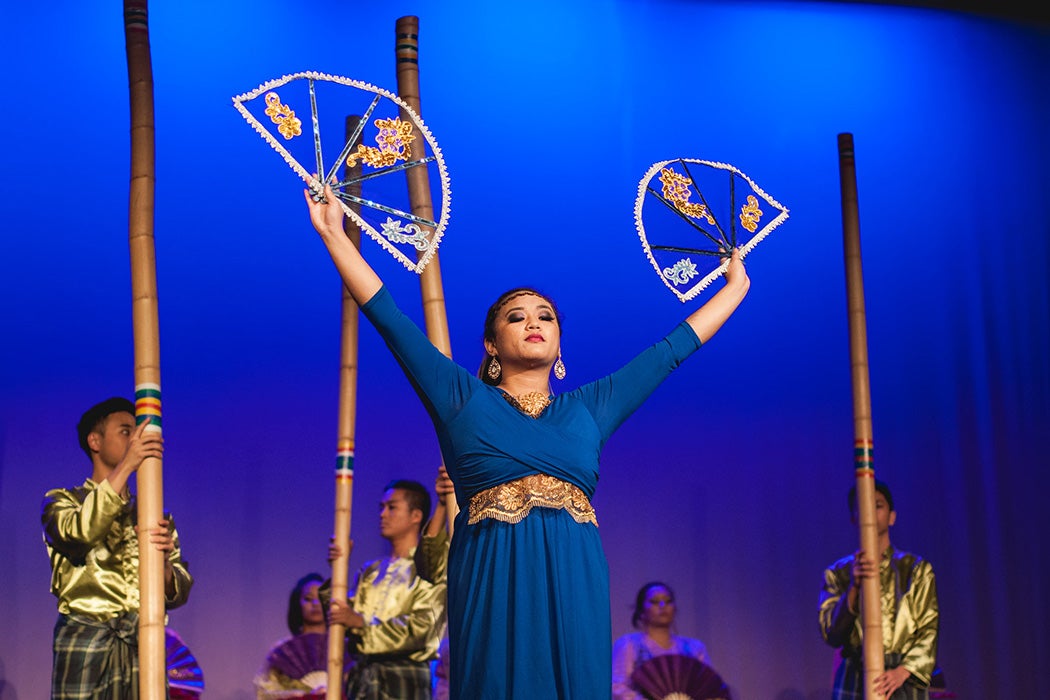If you went to a university with a significant Asian American population, you may have seen posters advertising Pilipino Culture Night (PCN) or even attended these cultural celebrations.
Traditional dances from the Philippines are central to the programming at PCNs, which are organized by campus-based Filipino American student groups and typically arranged in what sociologist Samuel Gilmore calls “a highly conventionalized presentation format.”
Describing selections from Spanish colonial dance to “the show-stopping gymnastics of the Tinikling”—the famed bamboo-pole dance—Gilmore explains that “no single dance or musical style dominates Filipino cultural heritage, an array of folk dances consisting of four distinct cultural ‘suites’ tend to make up the standard inventory of dance programming.”
But how do college students in campus organizations understand the role of their performances?
Despite the outsized influence of acclaimed Filipino troupe Bayanihan, which toured the world in the 1950s and 1960s and whose repertoire “presents a historically accepted array of music and dance practices that portray cultural identity,” Gilmore notes growing unease among some of the students who inherit its tradition. As he observes,
compared to the tradition-keeping processes of the rural village, where “participatory” cultural activities held in the collective memory of village elders are passed on to the younger generation through practice and imitation, Bayanihan’s documentation and presentation represents a traditional form at least one stage removed from “original” sources.
As such, “the negotiation of this authenticity issue for campus ethnic identity organizations has focused on what to accept or what not to accept from Bayanihan and what alternatives exist.”
Yet, authenticity is not the main goal. Student choreographers tell Gilmore that “they are highly constrained by the conventions of the PCN and the expectations of the audience.” Breaking away from conventions in pursuit of authenticity may disappoint and fail to entertain.
“Since the objective of campus ethnic identity organization is not primarily authenticity but an enthusiastic and entertaining celebration of ethnicity and identity formation, most participants do not object to some transformation of traditional music and dance practices,” he writes. “The result is the PCN-manufactured expression of tradition,” where traditional dances are reinterpreted in a Bayanihan performance style “constructed for dance audiences in urban settings.”
Gilmore contrasts these students’ relationship with traditional dance with two other social contexts in the Filipino American community: community associations and professional companies. In community associations, which grew with the increase of the Filipino American population in the 1970s and 1980s, traditional dance serves a nostalgic function.
“It is evident from interviews with older immigrants that music and dance activities are secondary to the political and charitable fund-raising goals of the associations,” he writes. Nevertheless, “cultural events are frequently used to bring in less active members who want to recall and relive hometown cultural experiences.”
Weekly Newsletter
Meanwhile, professional and semi-professional dance companies emphasize “the use of original authentication resources,” rather than relying second-hand on Bayanihan sources, although some troupes also aim for different degrees of “modernization” over tradition alone.
Traditional dance is not a “trivial or elite artistic focus” for many Filipino Americans, “but rather a mainstream activity that produces a sense of cultural substantiality within the Filipino community and a sense of pride and legitimacy when performed for those outside the community.” writes Gilmore. “[T]he reproduction of traditional music and dance in each setting represents a locally negotiated order constructing a living tradition.”
Support JSTOR Daily! Join our new membership program on Patreon today.







